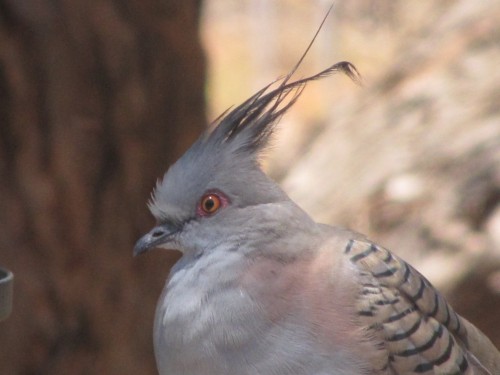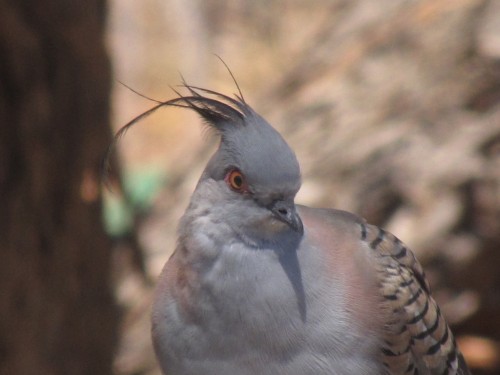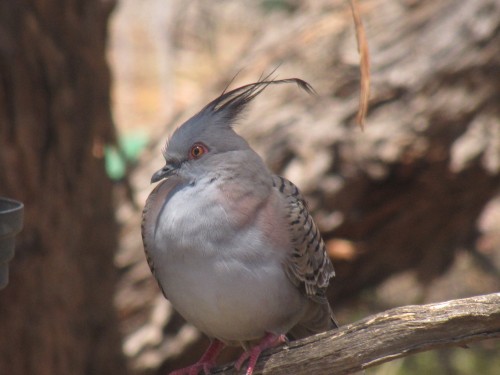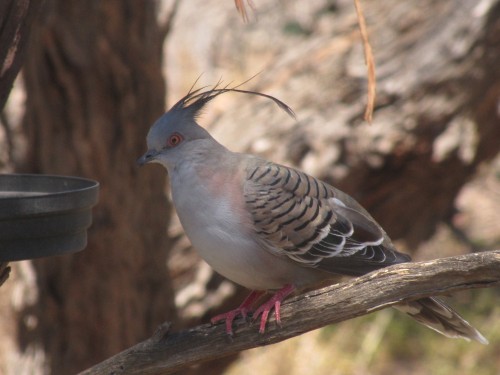Topsy the Crested Pigeon
Over recent weeks my wife and I have been intrigued by one of our resident Crested Pigeons – shown in the photos on today’s post. We suspect that she is a female because another pigeon was displaying to her recently. We have given her the name “Topsy” because she has some extra-long feathers making up her crest. I am not sure what has caused this slight aberration, but it certainly makes her stand out from the other pigeons in our garden.
Like all of the Crested Pigeons and Spotted Turtledoves resident in our garden and on our five-acre block, “Topsy” comes frequently to our bird baths for a drink. Today, while I was having a cuppa after lunch she came once again. She spent a few minutes on a nearby branch preening before flying down for a drink. She then flew down to the ground and sat down in the sunshine. She immediately lifted up one wing and held it with the underparts exposed to the warm sun. “Topsy” then stood up, changed position and raised the other wing in the same manner.
While I haven’t seen this sunbathing behaviour in many species I have observed it in Spotted Turtledoves, Red wattlebirds, Noisy Miners and Australian Magpies. It is surprising that there is very little mention of this behaviour in the literature, but this article on the Australian Birdlife site gives the topic a good coverage. The article suggests that this sunbathing behaviour could be aimed at ridding the birds of unwanted lice.
Further reading:
- Sunny side up – the article I referred to above
- An Australian Magpie sunning itself – this is an old post written some years ago. It shows a series of 10 photos of a magpie sunning itself.
Spotted Turtledove nesting
We usually have several Spotted Turtledoves hanging around somewhere in our garden. In the hot weather they are frequent visitors to our bird baths – to see photos click here.
They are also a resident breeding species in our garden here in Murray Bridge, South Australia. Quite often they go about their nesting quite unobtrusively and we never get to see their nests. The latest attempt, however, was several metres from our sun room where we often have our meals. We watched the progress of the nest over several days as the pair flew to the ground, selected suitable sticks and twigs and then flew back to the melaleuca bush.
I was rather cautious approaching the bush for the photo above because doves and pigeons can be very nervous on the nest, often flying off rapidly when approached and either damaging the nest or eggs, or abandoning it entirely.
Since taking this photo a few weeks ago the young have left the nest. Click on the photo to enlarge the image.
Spotted Turtledoves nesting
The Spotted Turtledove is an introduced bird species in Australia. They are very common in many cities and towns in much of Australia. We usually have a few resident in our garden and near the house. On many occasions they have made nests and raised little ones.
Two weeks ago we had a near disaster in our garden. We had a very large 15 metre gum tree come down in our driveway in a violent storm. You can see pictures of some of it on my writing site here.
A few days after the storm I noticed a Spotted Turtledove gathering small sticks on the ground just outside my office. It was carrying the sticks into the thickest part of the canopy of the fallen tree. Little did it know that I was about to cut up that part of the tree the next day. Our movement nearby and the noise of the chain saw just metres away obviously frightened it away.
Two days later my wife saw the bird carrying sticks to another tree nearby. This time it had chosen a tree which was not on my demolition plans. The next day it had changed its mind and was building a nest in a thick bush on the other side of the house, a site they had used successfully in previous breeding attempts. I will keep an eye on it.






